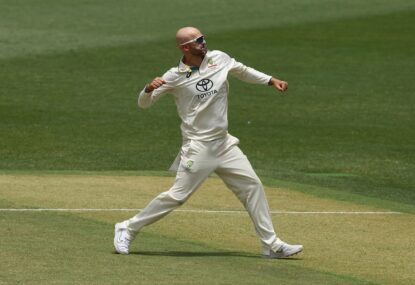Australia versus the West Indies – it’s Boxing Day 1981.
Without doubt it’s the most exciting, spine-tingling, sweaty palm-inducing day of Test cricket in my cricketing lifetime. It’s the best day ever.
As a 13-year-old boy I am simmering with excitement because my brothers and I got a table tennis table for Christmas. And now it’s a bright, blue and golden day – both in Sydney and at the MCG – and the gladiatorial contest I had been long awaiting is about to begin.
Does it get any better than this?
But soon my spirits are crushed. Stumpy Laird plays a loose stroke down the leg side and is caught by David Murray. Australia are 1-4.
Greg Chappell strides onto the field, plays a loose defensive stroke outside the off stump, turns to see David Murray pouch the outside edge and strides off the field again, provoking Michael Holding to raise his arms above his head and execute an improvised Calypso foxtrot. 2-4.
Then Graeme Wood is gone, also caught by Murray. I haven’t yet recovered from the loss of Laird and Chappell, and now this!
Australia 3-8. Will we survive the first session?
Now Kim Hughes is marching out to face the blitzkrieg of West Indian express bowling. He’s the Victor Trumper of his era, a batsman capable of sublime, ethereal stroke play, but fans have to endure some ugly failures before they can celebrate the triumphs.
Would this Boxing Day see Hughes deliver a triumph or a disaster?
But even before Kim’s innings starts to take shape, Border is out, playing an even looser stroke way outside his off stump, and than Chappell. Another catch to Murray. The Aussies are in a bottomless cesspool of trouble at 4-26.
Dirk Welham defiantly scores 17 before scooping a catch to Gus Logie at cover. That my brothers and I are celebrating a score below 20 is an indictment on Australia’s position. So is the fact that 5 for 59 feels like a fightback.
Yet Hughes is now in his twenties and beginning to exhibit some confidence. Andy Roberts muscles his way to the wicket and the ball hurtles towards Kim’s left hip. He executes a graceful bunny hop so that both feet are – quite remarkably – pointing down the pitch and deflects the ball sweetly towards backward square leg where it wallops into the yellow Walpamur sign hanging from the fence.
Roberts bustles in again with muscular menace and hurls the ball towards the base of the stumps. Hughes waits patiently for the ball to come to him – he doesn’t have to wait long – and with a still head and a straight bat, punches the ball down the ground into the long-off fence.
Sitting in front of the TV, I can feel the excitement flittering in my stomach. Those were some defiantly, aggressive strokes by Hughes. Is this the true start of a stirring fightback? Are we going to see something special on this glorious Boxing Day?
Michael Holding whispers in upon silent, athletic feet and, like a graceful spring unloading, whips the ball down the wicket, short and wide. Hughes steps back deep into his crease and smacks the ball, with calculated violence, through the off-side field to the distant point boundary.
On the replay, he resembles a dashing buccaneer; his bat slashing through the horizontal and performing a twirl above his head.
With boundaries to the west, north and east of his batting position, Hughes registers his half century to the south, with an inside edge between the wicket keeper and leg slip to the fence. He is, truly, playing strokes now to all corners of the ground.
With some belligerent help from Marsh, the Aussies are looking better at 5 for 111, but the recovery is short lived. Marsh’s skill falls short of his aggressive demeanour and he edges to Richards in the slips. Soon, Yardley, Lillee and Lawson follow him back to the dressing room and Australia look forlorn at 9 for a dismal 155.
Hughes is still alive; but occasional batsman, Terry Alderman, is joining him.
That the Aussies would progress from this position and end the day in a buoyant – almost dominant position – is why this epic day of Test Cricket remains the pre-eminent of all Test Cricket days in my lifetime.
With the last man in, Hughes decides it’s time to attack; fortune favours the brazenly, defiant brave.
As big Joel Garner lopes into his delivery stride, Hughes skips down the pitch – on a ballerina’s agile feet – ready to belt the ball over the bowler’s head. But Garner – perhaps sensing the batsman’s audacious advance – adjusts his release point so that the ball pitches short and ramps up sharply towards Hughes’ chest. But Kim is in the zone and his brain quickly adjusts. Banishing any thought of a stroke down the ground, Hughes pivots, swings across the line and muscles the ball to the mid-wicket fence.
Big Joel bowls again and Hughes, this time standing his ground, goes back and slices the ball – with perfect timing and a devil-may-care backswing – backward of point to the boundary once more.
Hughes is now on 84. Only now do my brothers and I start discussing the possibility of an unlikely century.
A single here. A well-placed double there. And suddenly the hero of the hour is on 96. Can he do it?
Joel Garner runs in again – on long loping legs – and pitches the ball short, so that it steeples towards the batsman’s chest, directly over middle stump. Hughes shapes to unleash another square cut, but finds he is rapidly running out of room as the ball spears spitefully towards him. Arching his back to an impossible angle, Kim raises his bat to the horizontal and smashes the ball forward of point.
As the vision swings urgently to the left of our TV screen, we see the West Indian fielders turn and chase.
He’s found the gap! Moments later, we see the ball meet the fence.
He’s done it! One hundred runs! Out of a total of just 198!
The Boxing Day crowd erupts into spasms of euphoric joy! So do we, in our family room in Dural. It’s an innings for the ages! We know, even in the moment, that his is one of the great Test Match centuries.

Cricket fans (AAP Image/Dave Hunt)
Hughes knows it too; as he pumps his arms in majestic celebration of his triumph.
But is 198 enough?
Soon the Aussies are out on the field and ready to take the attack to the West Indian batsman. As impossible as it seems, the true excitement of this extraordinary day is about to begin.
Terry Alderman – fresh from his stirring exploits with the bat – ambles into the wicket and unwinds his efficient metronomic action. Fauod Bacchus – who resembles one of Darth Vader’s storm troopers in his square white helmet – shuffles with intent and pokes an unconvincing bat at the wobbling ball. The edge flies, sharp and low, to Graeme Wood at third slip who takes the catch low to his left.
The Windies are 1 for 3. And the excitement in our family room rises to a new level of euphoria.
Now Lillee is pounding down like a machine…the Boxing Day crowd chanting his name and urging him to perform even greater exploits.
Desmond Haynes – perhaps trying to emulate Hughes’ feats from earlier in the day – aims an expansive cover drive to the outswinger; edges the ball; and is caught by Border in the slips.
Two for 5!
The most punishing batsman of the era, Viv Richards, is compelled to enter the cauldron. A nightwatchman – in the lanky form of Colin Croft – was sent in at the fall of the first wicket. But sentencing two nightwatchmen, no matter how late the hour, is a practical impossibility; so Richards has no choice.

Vivian Richards batting (Photo: S&G/PA Images via Getty Images)
But now Lillee is running in to bowl to Croft. His lightening fast steps lengthen as he approaches the wicket, the crowd still yelling his name with hoarse expectation. Turning side-on, Lillee leaps into his classic delivery stride and unleashes the ball in a perfect windmill action. Croft, like so many before him, is mesmerised as he shuffles across his stumps and the ball cannons into his pads.
The Australian appeal is met with an immediate positive response from Umpire Crafter.
The Windies are 3 for 6.
Suddenly, it’s the last ball of an extraordinary, unprecedented day of Test cricket.
Yet the true moment of gladiatorial conquest is yet to come.
Lillee – that once-in-a-generation fast bowler – is about to bowl to Richards; the most feared batsman of his time.
Though they had battled against each other before, this is the moment.
Richards uses his teeth to adjust his left batting glove before entering his relaxed, yet menacing, stance. He chews at his gum with furious intent. Lillee sprints in again; his arms pumping rhythmically to the beat of my hopeful boyish heart.
My whole body is tense with excitement. Nothing else in the world exists as I focus all my attention on the drama playing out on my television screen. How will this day end? I’ve savoured so much, yet – like a glutton – I still want more.
Lillee bursts into his delivery stride and sends down an outswinger which jags back off the seam.
Richards, ever-keen to assert his dominance, steps forward for the cover drive but – in the heat of this moment of primordial contest – misjudges the off-cutter. The ball nips the inside edge and the thud of leather against cricket stump is a sound heard all over the cricketing world.
Richards completes his follow-through, now with one hand off the bat, stands up straight and, in the briefest of moments, looks at his nemesis with admiration before trudging from the field, crestfallen but resigned.
Lillee releases a roar of primeval conquest and runs from the field in triumph; his acolytes whopping and hollering in joy behind him. The crowd is in such a feverish frenzy that they may well invade the field. At home, my brothers and I are screaming with hysteria. We can’t believe it. The West Indies 4 for 10!
What a day!
Days of gladiatorial contest
As soon as the Channel 9 telecast ended – and Richie bid us a good evening – my brothers and I joined my father in a game of ping pong on our new table. Our hearts were still pounding with excitement and I could barely grip the paddle for the sweat on my palms. We were all inspired by what we had just seen.
For the record, Lillee went on to take the wickets of Dujon and Gomes the next day, to break the record held by Lance Gibbs for the most number of wickets in Test Matches and Australia won the Test by 58 runs.
Most sports – when played at their best – boast an element of gladiatorial conquest.
But what sets Test cricket apart is that, to thrive, the batsman must take on – and defeat – all eleven men in the opposing team.
As the bowler runs in, the batsman is all alone. All he can hear are the footsteps of the bowler’s approach and, perhaps, the beating of his anxious heart. He has a comrade at the other end, but he may as well be in the dressing room, with the rest of the team, because only the batsman at the striker’s end can play the ball as it hurtles down the pitch towards him.
Pitted against the batsman – intent on taking his wicket or, at least, preventing him from scoring – are the bowler, the wicket-keeper and every one of the nine fieldsmen.
It can be a lonely place; particularly when a hostile crowd is baying, without mercy, for your blood.
That the batsmen regularly overpower every man in the opposing team is a testament to the gladiatorial element to the game; the gallant batsman prevailing against all the odds.
That Boxing Day in 1981 will live in my memory forever. It was an epic contest between bat and ball. Kim Hughes took on a fast bowling attack boasting Holding, Garner, Roberts and Croft and triumphed. And then Lillee conquered King Viv.
But it is not the only day of gladiatorial clashes I have witnessed. And it doesn’t take a fast bowler to create a gladiatorial atmosphere.
I was at the SCG in January 1994 – my first Test as a Member – when Shane Warne took 7 wickets on the first day. From the moment Warne bowled Callinan with a flipper, the Sydney crowd were hunting for South African blood. That Warne bowled slowly – with a short run-up and a looping trajectory – only added to the suspense. Every ball was met with a gasp of anticipation followed by either a squealed missed opportunity or a raucous, blood-thirsty celebration when another wicket fell.
Surely, the gladiators of Roman times never created such a spectacle of wild hysteria!






































































































